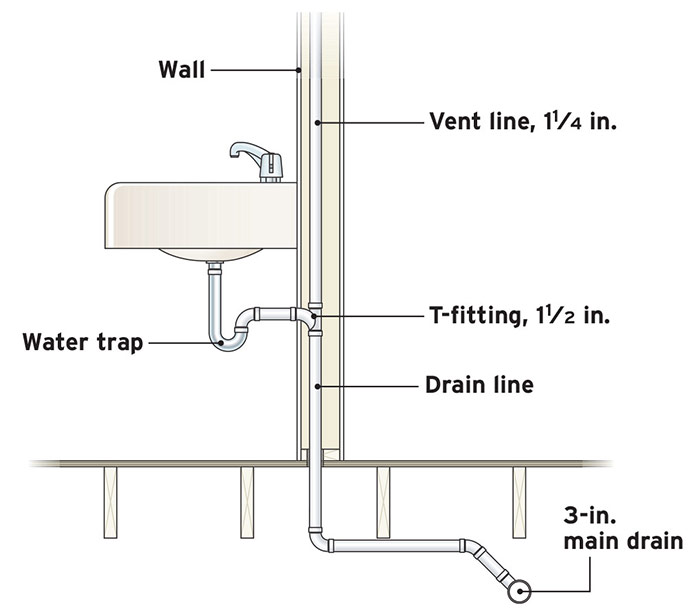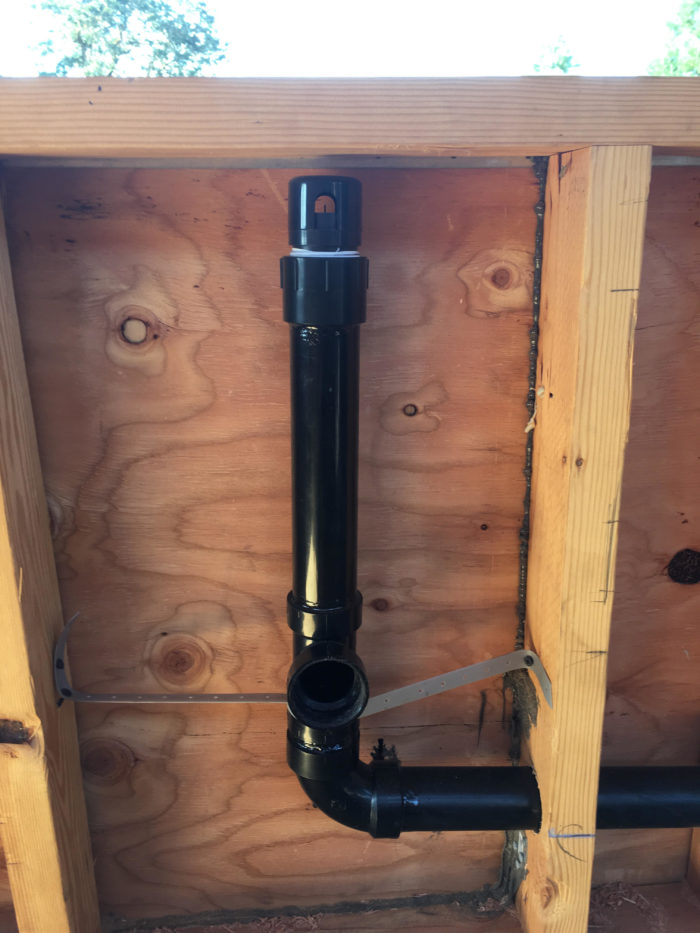We have uncovered this post pertaining to What Are Plumbing Vents and Why Are They Important? below on the web and decided it made sense to talk about it with you here.

Proper air flow in plumbing systems is commonly forgotten, yet it is crucial for preserving the performance and safety of your home's plumbing. Ventilation assists manage atmospheric pressure, prevent the buildup of harmful gases, and ensure the reliable removal of waste. In this guide, we will certainly discover the significance of appropriate plumbing air flow, exactly how it functions, and the advantages it gives your pipes system.
Recognizing Air Flow in Pipes
Ventilation in pipes describes the network of pipes that permit air to move with the drain system. These vents offer numerous functions, consisting of managing air pressure within the pipes, preventing sewage system gases from going into the home, and helping in the smooth circulation of wastewater.
Exactly How Ventilation Functions in Plumbing Solutions
Atmospheric Pressure Guideline
Correct ventilation maintains balanced atmospheric pressure within the plumbing system. When water streams via pipes, it displaces air. Without appropriate ventilation, this displacement can create negative pressure, leading to reduce drains pipes or siphoning of water from catches, which can trigger undesirable smells to seep into the home.
Protecting Against Sewer Gas Accumulation
One of the most critical features of pipes vents is to avoid drain gases, such as methane and hydrogen sulfide, from building up within the home. These gases can present severe health and wellness threats and are very flammable. Vent pipelines allow these gases to get away securely outside.
Helping in Waste Removal
Ventilation assists in the efficient removal of wastewater by protecting against airlocks in the water drainage system. When air can move easily through the vents, it permits water and waste to stream efficiently via the pipes, decreasing the risk of blockages and back-ups.
Kinds Of Plumbing Vents
Key Stack Vent
The primary pile air vent, additionally called the air vent stack, is the primary air vent in a pipes system. It prolongs from the primary drain align via the roofing system, enabling gases to run away and fresh air to get in the system.
Branch Vent
Branch vents link to the major stack vent and serve individual components, such as sinks, bathrooms, and showers. These vents guarantee that each fixture has appropriate ventilation to operate effectively.
Air Admittance Shutoff (AAV).
An Air Admission Valve (AAV) is a one-way shutoff that permits air to get in the pipes system without the requirement for a standard air vent pipeline extending through the roof covering. AAVs are typically used in remodellings or locations where setting up a typical air vent is not practical.
Signs of Poor Ventilation in Pipes.
Slow Draining Fixtures.
If your sinks, tubs, or commodes are draining gradually, it could be an indication of inadequate ventilation. Insufficient air circulation can create a vacuum effect, making it difficult for water to drain pipes appropriately.
Gurgling Seems.
Gurgling noises originating from drains pipes are commonly a result of air being sucked via water catches due to negative stress in the pipelines. This is a clear indication of insufficient ventilation.
Unpleasant Smells.
Sewage system odors inside your home are a red flag that your plumbing system is not appropriately ventilated. This might suggest that sewage system gases are not being sufficiently aired vent outside, resulting in possibly hazardous problems.
Typical Ventilation Blunders.
Inadequate Vent Sizing.
Utilizing undersized vent pipes can cause bad air flow and pressure discrepancies in the system. It's important to utilize vents that meet the particular requirements of your pipes system.
Improper Vent Positioning.
Placing vents as well much from the components they serve can decrease their efficiency. Correct placement makes sure that air can flow freely and effectively through the system.
Ignoring Code Demands.
Building ordinance give particular standards for pipes air flow. Disregarding these codes can lead to a system that fails to operate properly and might cause pricey fixings or health hazards.
Advantages of Appropriate Air Flow.
Boosted System Performance.
Properly ventilated plumbing systems run more efficiently, with fewer clogs, faster draining pipes, and much less strain on the pipes. This efficiency expands the lifespan of the plumbing system.
Improved Air Quality.
By stopping drain gases from entering your home, proper air flow adds to much better interior air quality, making your living atmosphere healthier and a lot more comfortable.
Avoiding Water Damages.
Adequate ventilation helps protect against water from being siphoned out of traps, which can cause sewage system gases going into the home and causing water damages in time.
Steps to Ensure Correct Ventilation.
Consulting Plumbing Codes.
Always seek advice from neighborhood plumbing codes when developing or modifying your pipes system. These codes provide the essential standards for correct venting and ensure your system meets security requirements.
Normal Assessment and Upkeep.
Regular examinations can aid determine prospective ventilation concerns prior to they become significant troubles. Upkeep jobs, such as cleaning up air vent pipelines and checking for blockages, are essential for maintaining the system in good working order.
Professional Setup.
For brand-new installations or major modifications, it's smart to employ a specialist plumbing. They have the competence to ensure the air flow system is appropriately created and mounted according to code.
Final thought.
Appropriate air flow is an important component of any plumbing system, making sure that it works successfully and securely. By recognizing the significance of air flow, acknowledging the indications of poor air flow, and taking steps to keep your system, you can stop pricey issues and shield your home's air quality.
4 Things You Should Know About Your Plumbing Vents
What Plumbing Vents Are
Also called a vent stack, a plumbing vent is a vertical pipe attached to your drain line that runs through your roof. The plumbing vent pipe, or plumbing air vent, removes gas and odors from your plumbing system and allows fresh air to enter the pipes, helping the water to flow out of the drain pipes.
What Plumbing Vents Do
Plumbing vents have two basic functions. One of which is to allow unpleasant smelling wastewater and sewer gasses to escape your plumbing system instead of entering your home. Plumbing vent pipes are typically located on roofs, away from windows, to ensure the fumes exit the home completely.
The other function of the plumbing vent is to move fresh air into your plumbing system. This helps move water through every plumbing fixture in your house, like toilets and sink drains. Think of the way in which you need to let a little air into the bottle as you pour soda in order to make the drink flow smoothly.
Different Types of Plumbing Vents
- True vent: This is the most common vent option. In simplest terms, a true vent is a vertical pipe attached to your drain line that exits through the roof. They often function as the main vent that other fixtures can connect to.
- Re-vent pipe or auxiliary vent: Attached to the drain line near specific plumbing fixtures, re-vent pipes run up and over to connect to the main vent.
- Common vent: Two plumbing fixtures installed on opposite sides of a wall are typically tied into the vent stack using something known as a sanitary cross.
- Wet vent: This venting option operates as a drain pipe and a vent at the same time. Wet vent drainage systems drain water from one fixture while venting the air from another. Although they’ve been used for over 100 years, wet vent systems have only recently been added to the plumbing code in many areas. If you’re planning on installing one in a bathroom remodel, make sure you check your local code prior to construction.
- Loop vent: For free-standing fixtures like kitchen island sinks, loop vents are ideal. These vent pipes run under the floor, rise from the P-trap, and create a loop inside the cabinet sink.
- Air admittance valve: An AAV is a one-way mechanical valve typically installed at the site of the plumbing fixture. AAVs allow venting to occur without having to tie into a larger venting system. They’re ideal for venting fixtures where you aren’t able to easily connect to an existing vent system.
Common Plumbing Vent Issues
Although vent pipes typically don’t have water flowing through them, they’re still subject to many typical plumbing issues. For example, clogs are one of the most common problems associated with sewer vent pipes. If your vent pipe gets clogged, all of your plumbing fixtures tied into the vent stack will be affected.
A sink with a slow drain that bubbles and gurgles or a strong sewage smell around your toilet are both indicators that your toilet vent pipe is clogged. Because most vent pipes exit through the roof, old leaves, twigs or even a bird’s nest could be clogging the pipe.
Clogs in your vent pipe system cause a buildup of negative pressure, meaning that water won’t be able to flow out of your home very well. It’s similar to putting your finger over the opening of a straw to trap water inside. When you remove your finger, the water is able to flow out of the straw.
If you suspect you have any blockage in your vent, make sure you have a professional come examine the situation. Left unchecked, a blocked air vent can lead to other costly repairs, like leaks and sediment buildup.
Under Pressure
Pipe vents are essential aspects of a home’s plumbing system. Owning a home means learning about all sorts of things you never put much thought into before. But by understanding as much as you can about the important systems of your home, you can keep those budgets intact and those anxiety levels low.
https://www.homeserve.com/en-us/blog/home-improvement/plumbing-vents/

I recently found that page about What Are Plumbing Vents and Why Are They Important? when perusing the internet. Make sure you take the time to share this entry if you enjoyed reading it. Thanks a lot for your time. Don't forget to check up our blog back soon.
Call Today
Comments on “Exploring The Importance of Correct Ventilation in Plumbing Systems”